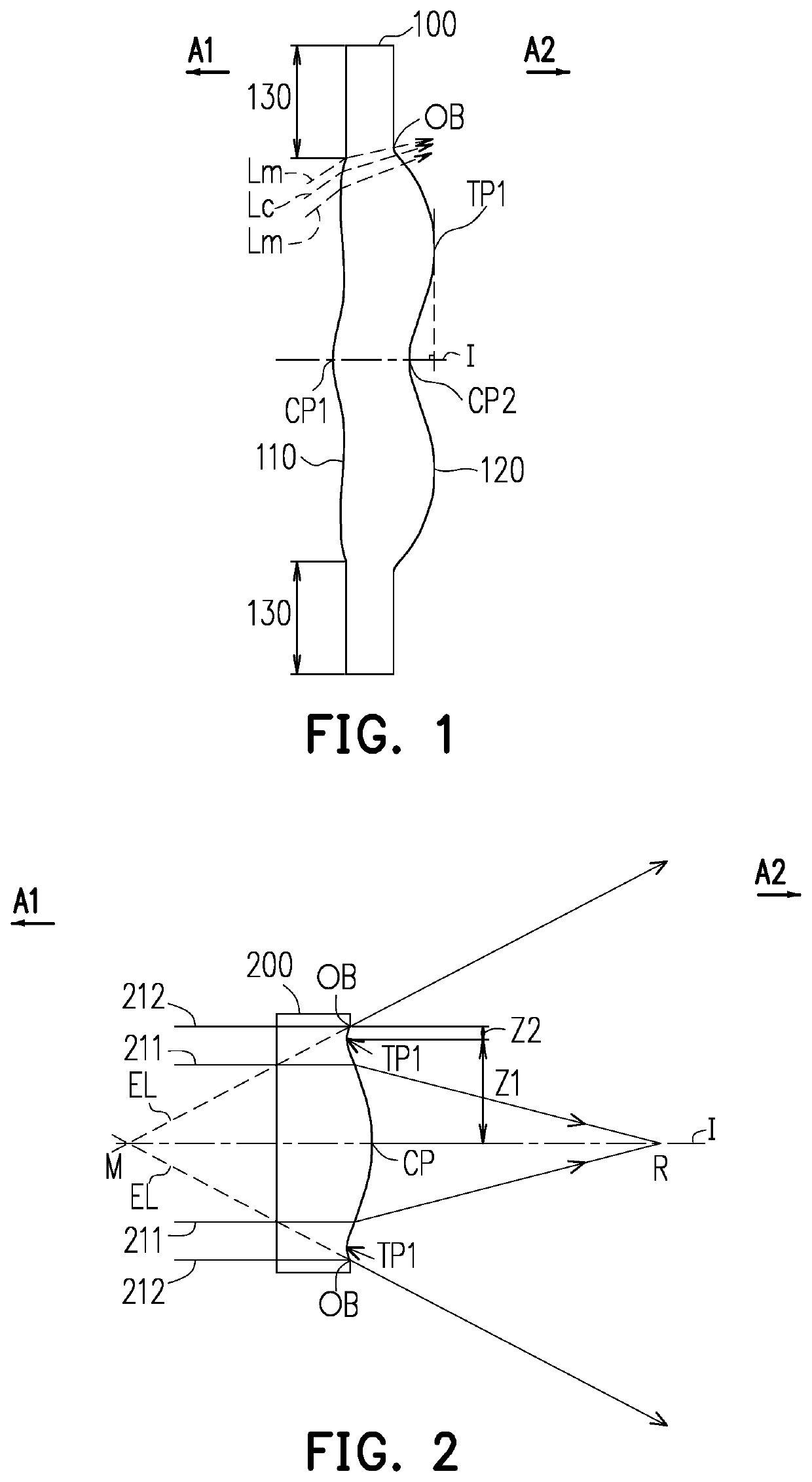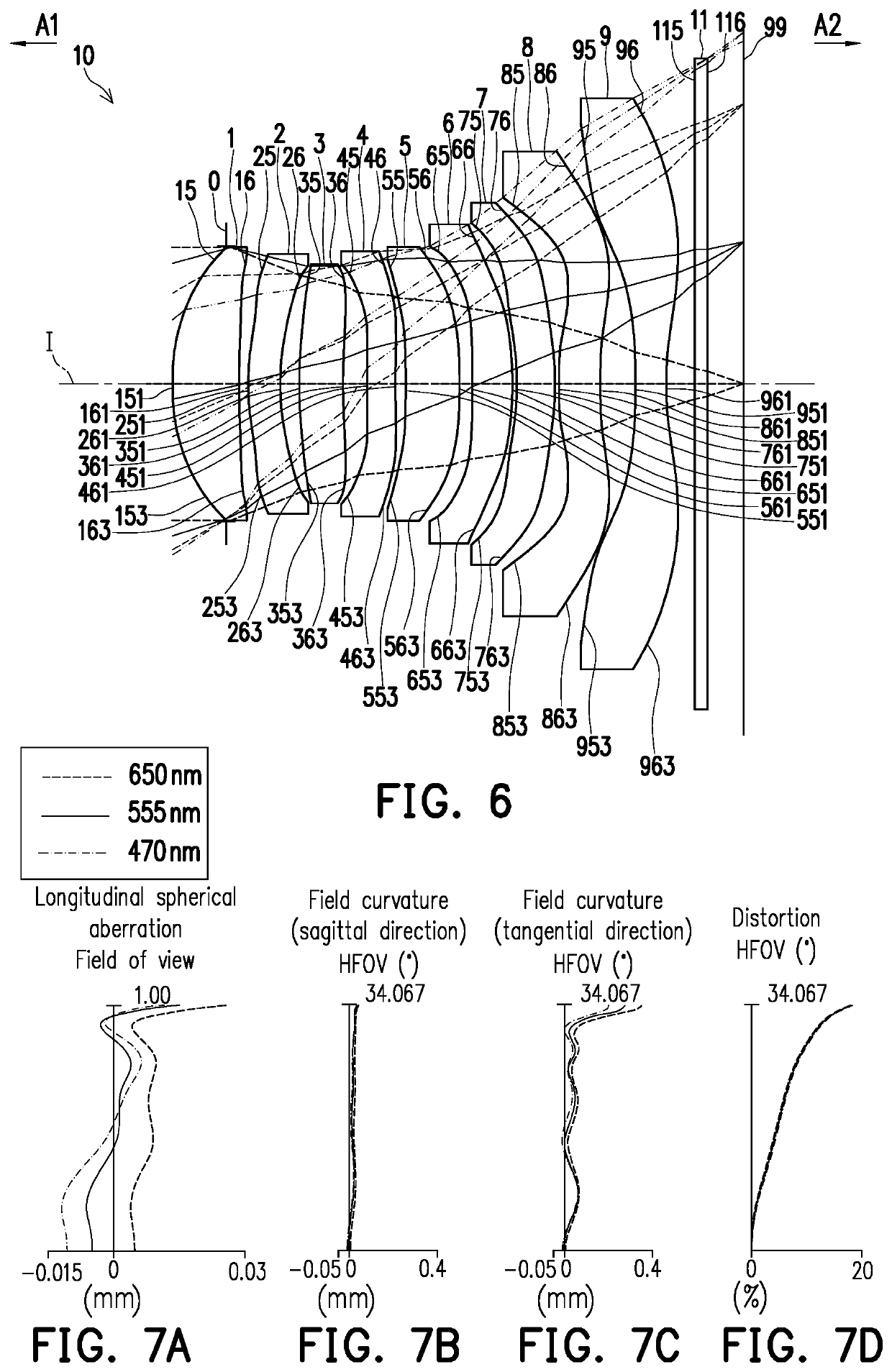Optical imaging lens
a technology of optical imaging and lens, applied in the field of optical devices, can solve the problems of increasing distance, no avail for thinning mobile phones and digital cameras, etc., and achieve the effects of reducing the f-number (fno) reducing the system length of the optical imaging lens, and increasing the image heigh
- Summary
- Abstract
- Description
- Claims
- Application Information
AI Technical Summary
Benefits of technology
Problems solved by technology
Method used
Image
Examples
first embodiment
[0098]In addition, a relationship between important parameters in the optical imaging lens 10 of the first embodiment is as shown in FIG. 50 and FIG. 51.
[0099]Where,
[0100]f1 is a focal length of the first lens element;
[0101]f2 is a focal length of the second lens element;
[0102]f3 is a focal length of the third lens element;
[0103]f4 is a focal length of the fourth lens element;
[0104]f5 is a focal length of the fifth lens element;
[0105]f6 is a focal length of the sixth lens element;
[0106]f7 is a focal length of the seventh lens element;
[0107]f8 is a focal length of the eighth lens element;
[0108]f9 is a focal length of the ninth lens element;
[0109]n1 is a refractive index of the first lens element;
[0110]n2 is a refractive index of the second lens element;
[0111]n3 is a refractive index of the third lens element;
[0112]n4 is a refractive index of the fourth lens element;
[0113]n5 is a refractive index of the fifth lens element;
[0114]n6 is a refractive index of the sixth lens element;
[0115]...
second embodiment
[0160]As shown in FIG. 13, FIG. 13 illustrates various aspheric coefficients of the object-side surface 15 of the first lens element 1 to the image-side surface 96 of the ninth lens element 9 of the second embodiment in the above equation (1).
[0161]In addition, a relationship between important parameters in the optical imaging lens 10 of the second embodiment is shown in FIG. 50 and FIG. 51.
[0162]The longitudinal spherical aberration of the second embodiment is as shown in FIG. 11A, and the deviation of the imaging points of the off-axis rays of different heights is controlled within a range of ±0.018 mm. In the two field curvature aberration diagrams of FIG. 11B and FIG. 11C, a focal length variation of the three representative wavelengths within the entire field of view range falls within ±0.06 mm. The distortion aberration diagram in FIG. 11D shows that the distortion aberration of the embodiment is maintained within a range of ±6%.
[0163]From the above description, it is known th...
third embodiment
[0166]As shown in FIG. 17, FIG. 17 illustrates various aspheric coefficients of the object-side surface 15 of the first lens element 1 to the image-side surface 96 of the ninth lens element 9 of the third embodiment in the above equation (1).
[0167]In addition, a relationship between important parameters in the optical imaging lens 10 of the third embodiment is shown in FIG. 50 and FIG. 51.
[0168]The longitudinal spherical aberration of the third embodiment is as shown in FIG. 15A, and the deviation of the imaging points of the off-axis rays of different heights is controlled within a range of ±0.06 mm. In the two field curvature aberration diagrams of FIG. 15B and FIG. 15C, a focal length variation of the three representative wavelengths within the entire field of view range falls within ±0.07 mm. The distortion aberration diagram in FIG. 15D shows that the distortion aberration of the embodiment is maintained within a range of ±2.5%.
[0169]From the above description, it is known that...
PUM
 Login to View More
Login to View More Abstract
Description
Claims
Application Information
 Login to View More
Login to View More - R&D
- Intellectual Property
- Life Sciences
- Materials
- Tech Scout
- Unparalleled Data Quality
- Higher Quality Content
- 60% Fewer Hallucinations
Browse by: Latest US Patents, China's latest patents, Technical Efficacy Thesaurus, Application Domain, Technology Topic, Popular Technical Reports.
© 2025 PatSnap. All rights reserved.Legal|Privacy policy|Modern Slavery Act Transparency Statement|Sitemap|About US| Contact US: help@patsnap.com



